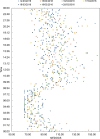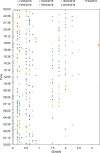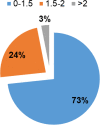A case study to investigate the impact of overcrowding indices in emergency departments
- PMID: 35945503
- PMCID: PMC9360659
- DOI: 10.1186/s12873-022-00703-8
A case study to investigate the impact of overcrowding indices in emergency departments
Abstract
Background: Emergency department (ED) overcrowding is widespread in hospitals in many countries, causing severe consequences to patient outcomes, staff work and the system, with an overall increase in costs. Therefore, health managers are constantly looking for new preventive and corrective measures to counter this phenomenon. To do this, however, it is necessary to be able to characterize the problem objectively. For this reason, various indices are used in the literature to assess ED crowding. In this work, we explore the use of two of the most widespread crowding indices in an ED of an Italian national hospital, investigate their relationships and discuss their effectiveness.
Methods: In this study, two of the most widely used indices in the literature, the National Emergency Department Overcrowding Scale (NEDOCS) and the Emergency Department Working Index (EDWIN), were analysed to characterize overcrowding in the ED of A.O.R.N. "A. Cardarelli" of Naples, which included 1678 clinical cases. The measurement was taken every 15 minutes for a period of 7 days.
Results: The results showed consistency in the use of EDWIN and NEDOCS indices as measures of overcrowding, especially in severe overcrowding conditions. Indeed, in the examined case study, both EDWIN and NEDOCS showed very low rates of occurrence of severe overcrowding (2-3%). In contrast, regarding differences in the estimation of busy to overcrowded ED rates, the EDWIN index proved to be less sensitive in distinguishing these variations in the occupancy of the ED. Furthermore, within the target week considered in the study, the results show that, according to both EDWIN and NEDOCS, higher overcrowding rates occurred during the middle week rather than during the weekend. Finally, a low degree of correlation between the two indices was found.
Conclusions: The effectiveness of both EDWIN and NEDOCS in measuring ED crowding and overcrowding was investigated, and the main differences and relationships in the use of the indices are highlighted. While both indices are useful ED performance metrics, they are not always interchangeable, and their combined use could provide more details in understanding ED dynamics and possibly predicting future critical conditions, thus enhancing ED management.
Keywords: ED evaluation indices; Emergency department work index (EDWIN); National Emergency Department Overcrowding Scale (NEDOCS); Overcrowding in emergency department (ED).
© 2022. The Author(s).
Conflict of interest statement
The authors declare that they have no competing interests.
Figures





Similar articles
-
Comparison of the National Emergency Department Overcrowding Scale and the Emergency Department Work Index for quantifying emergency department crowding.Acad Emerg Med. 2006 May;13(5):513-8. doi: 10.1197/j.aem.2005.12.009. Epub 2006 Mar 21. Acad Emerg Med. 2006. PMID: 16551777
-
Overcrowding analysis in emergency department through indexes: a single center study.BMC Emerg Med. 2022 Nov 18;22(1):181. doi: 10.1186/s12873-022-00735-0. BMC Emerg Med. 2022. PMID: 36401158 Free PMC article.
-
Validation of the Emergency Department Work Index in a Pediatric Freestanding Community Emergency Department.Pediatr Emerg Care. 2024 Oct 1;40(10):705-710. doi: 10.1097/PEC.0000000000003247. Epub 2024 Jul 24. Pediatr Emerg Care. 2024. PMID: 39051989
-
Measures of Emergency Department Crowding, a Systematic Review. How to Make Sense of a Long List.Open Access Emerg Med. 2022 Jan 4;14:5-14. doi: 10.2147/OAEM.S338079. eCollection 2022. Open Access Emerg Med. 2022. PMID: 35018125 Free PMC article. Review.
-
Care in the emergency department: how crowded is overcrowded?Acad Emerg Med. 2004 Oct;11(10):1097-101. doi: 10.1197/j.aem.2004.07.004. Acad Emerg Med. 2004. PMID: 15466155 Review.
Cited by
-
Measuring the crowding of emergency departments: an assessment of the NEDOCS in Lombardy, Italy, and the development of a new objective indicator based on the waiting time for the first clinical assessment.BMC Emerg Med. 2024 Oct 17;24(1):196. doi: 10.1186/s12873-024-01112-9. BMC Emerg Med. 2024. PMID: 39420258 Free PMC article.
-
The emergency department carbon footprint calculator: Design and validation.Medicine (Baltimore). 2025 May 30;104(22):e41652. doi: 10.1097/MD.0000000000041652. Medicine (Baltimore). 2025. PMID: 40441234 Free PMC article.
-
Perceived Causes and Effects of Overcrowding Among Nurses in the Emergency Departments of Tertiary Hospitals: A Multicenter Study.Risk Manag Healthc Policy. 2024 Apr 20;17:973-982. doi: 10.2147/RMHP.S454925. eCollection 2024. Risk Manag Healthc Policy. 2024. PMID: 38660020 Free PMC article.
-
Predicting emergency department admissions using a machine-learning algorithm: a proof of concept with retrospective study.BMC Emerg Med. 2025 Jan 6;25(1):3. doi: 10.1186/s12873-024-01141-4. BMC Emerg Med. 2025. PMID: 39762754 Free PMC article.
-
A pediatric emergency prediction model using natural language process in the pediatric emergency department.Sci Rep. 2025 Jan 28;15(1):3574. doi: 10.1038/s41598-025-87161-x. Sci Rep. 2025. PMID: 39875462 Free PMC article.
References
-
- Kelen GD, et al. Emergency department crowding: the canary in the health care system. NEJM Catalyst Innovations in Care Delivery. 2021;2(5).
-
- Volochtchuk AV, Lachowski; Leite, Higor. Process improvement approaches in emergency departments: a review of the current knowledge. Int J Qual Reliabil Manag. 2021.
MeSH terms
LinkOut - more resources
Full Text Sources

